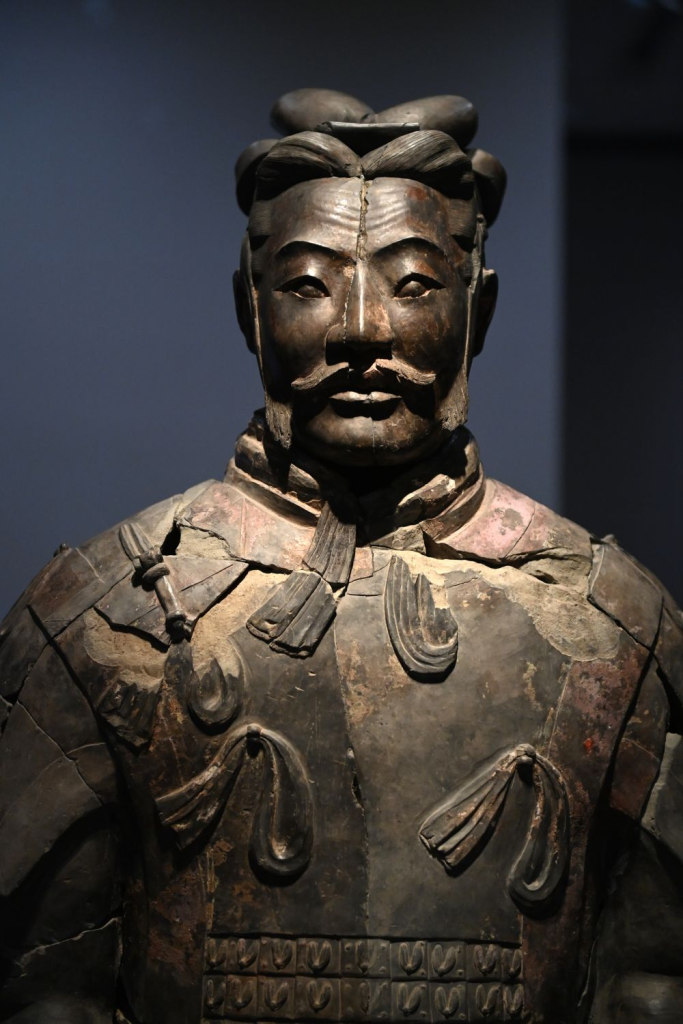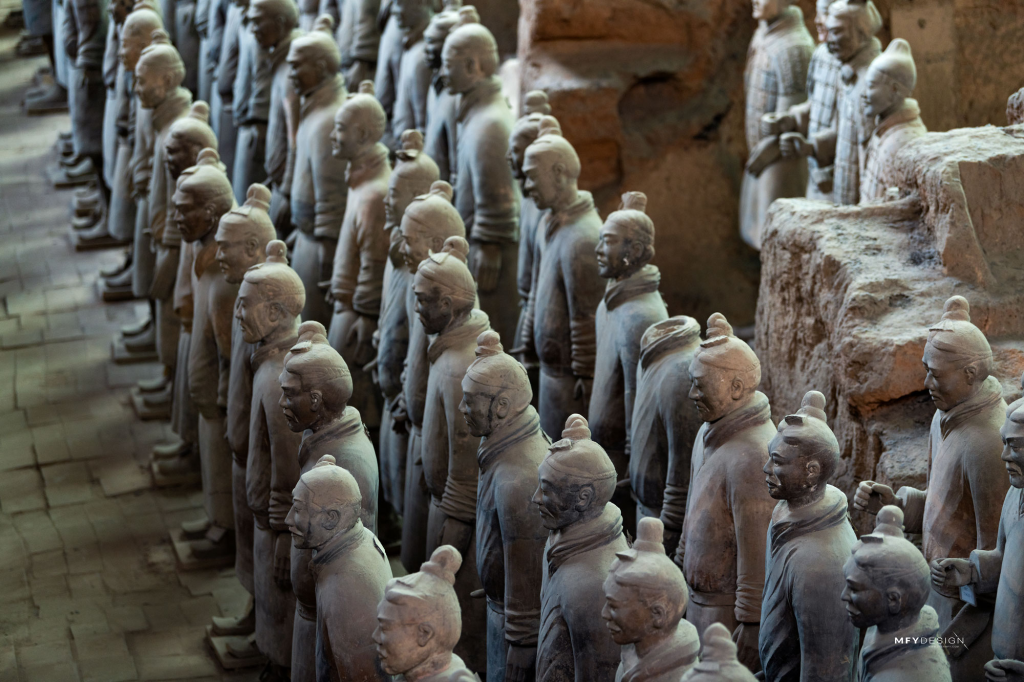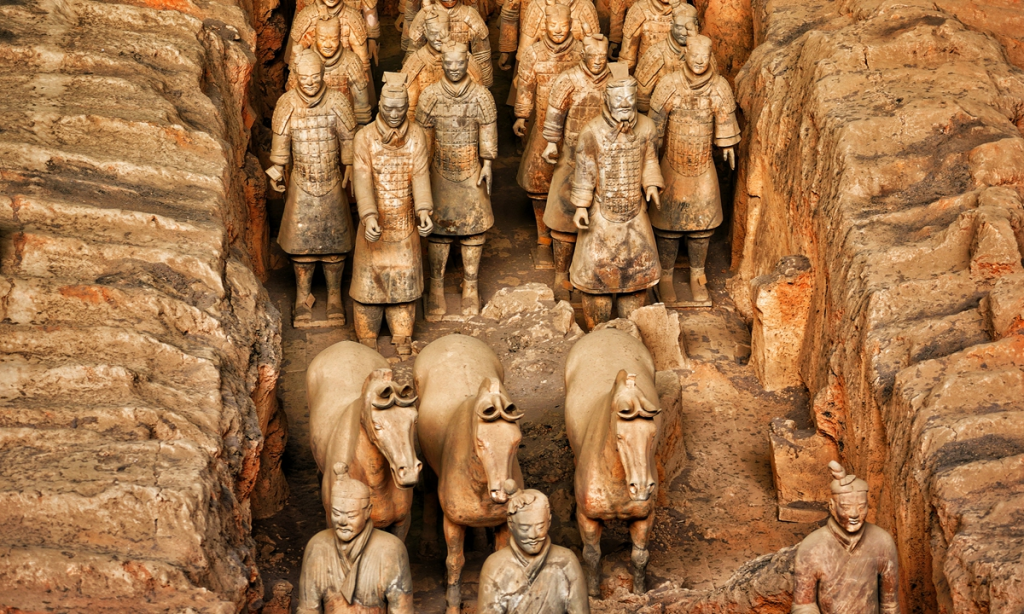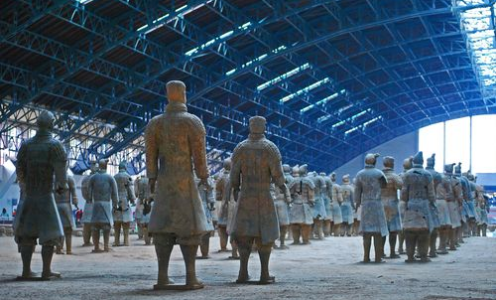It was in 1974 that the Terracotta Warriors were discovered close to Xi’an, China. These warriors are a breathtaking testament to the artistic prowess and imperial ambition of ancient times. These life-sized figures, which depict the army of Qin Shi Huang, the first Emperor of China, are more than just statues; they are a window into a significant moment in the history of China. The Terracotta Army, which was designated as a UNESCO World Heritage Site in 1987, is a treasure that is recognized all over the world. It attracts millions of visitors every year who come to marvel at this remarkable archaeological discovery.
A Quiet Struggle Against the Elements and the Passage of Time
There is no simple task involved in preserving the Terracotta Warriors. It is a never-ending struggle against a wide variety of dangers, both natural and those that are caused by humans. The warriors are forced to contend with a persistent assault from their surroundings. Humidity, fluctuating temperatures, and the ever-present specter of air pollution are all factors that contribute to the deterioration of the terracotta material and the precious painted surfaces that were once used to adorn these figures with vibrant colors. 💨
Terracotta, by its very nature, poses a significant challenge that must be overcome successfully. Because of its porous nature, it is extremely prone to cracking and other forms of damage. The kind of fragility that we are dealing with is comparable to that of a delicate sponge that has been exposed to the elements for three hundred years. Additionally, what about the pigments, which are the remnants of the warriors’ original, colorful glory? The delicate nature of these items is characterized by their tendency to flake and disappear, much like ancient whispers. 🎨
Although the sheer number of visitors is evidence of the significance of the location, it also adds to the level of difficulty associated with its preservation. When there are more feet, there is a greater chance that there will be accidental damage on the pits, and there will be a greater strain on the environment. Protecting this wonder from the very people who come to admire it while simultaneously sharing it with the world is a delicate balancing act that requires a lot of effort. 🚶♂️🚶♀️

The Museum’s Function as a Keeper of the Nation’s History
Not only is the Museum of the Terracotta Army a place to exhibit these remarkable artifacts, but it is also at the forefront of the fight to ensure that they are preserved until future generations. Since the museum serves as the central command, it is responsible for monitoring all aspects of conservation and ensuring the warriors’ continued existence over the long term. You can think of it as a specialized hospital that is committed to the health and well-being of these ancient soldiers. 🏥
The creation of an environment that is carefully controlled is one of the most fundamental protective measures that can be established. There are climate-control systems installed in the pits that are used to house the warriors. These systems meticulously regulate the levels of temperature and humidity. These systems perform the function of a protective bubble, shielding the terracotta from the most severe effects that the outside world can throw at it. It is akin to the creation of a microclimate that is perfect and stable, specifically designed to meet the requirements of the warriors.
The site itself is broken up into three primary pits, each of which is a different location for archaeological excavations. And the conservation strategy for each pit must be different from the others. In recognition of the fact that the difficulties can vary significantly from one section to another, the strategies are adapted to the particular condition of the warriors that can be found in each area. This approach is tailored to the specific requirements of each warrior, ensuring that they receive the appropriate level of care.
The intersection of science and archaeology in high-tech preservation
Today, preservation encompasses a much wider scope than simply ensuring that the warriors are housed in a secure environment. A remarkable combination of ancient history and cutting-edge technology is being utilized in this endeavor. Digital mapping and three-dimensional scanning are bringing about a revolution in the way that conservators keep an eye on the warriors. The use of these technologies enables specialists to monitor even the most minute changes over the course of time, as they generate records of the condition of each figure that are extremely detailed and accurate. Being able to detect subtle shifts that would be invisible to the naked eye is akin to possessing a magnifying glass that is more powerful than an ordinary magnifying glass.
An additional essential component of the preservation effort is the examination of the materials. Scientists conduct an in-depth investigation into the composition of the terracotta as well as the pigments that are still present. They are able to develop targeted conservation methods by first gaining a molecular understanding of the materials. This allows them to ensure that the treatments are both effective and safe for the delicate artifacts that they are working with. Before prescribing a treatment, it is comparable to conducting a comprehensive medical examination in order to gain an understanding of the underlying cause of a problem.
The objective is to reduce the amount of intervention that contains the potential to cause harm to the warriors. The use of techniques that are not invasive comes into play at this point. These techniques, which include X-ray fluorescence and infrared spectroscopy, make it possible for researchers to examine the composition and structure of the warriors without causing any harm to them. It is comparable to obtaining an X-ray or an MRI, as it allows for the collection of vital information without the need for surgical intervention.
Restoring the Colors That Have Been Lost: A Puzzle for Painters
The fact that the Terracotta Warriors were once painted in vivid colors is one of the most fascinating aspects of these ancient sculptures. Imagine rows upon rows of soldiers, not dressed in the muted earth tones that we see today, but dressed in a riot of vibrant colors! Unfortunately, over the course of the centuries, the majority of those pigments have either faded or flaked off, leaving behind only tantalizing hints of their former glory.
The restoration of these colors that have been lost is a laborious and difficult process. In order to prevent further pigment loss, conservationists employ cutting-edge techniques to stabilize the pigments that are still present. It is common practice to apply protective coatings, which are selected with great care to ensure that they are compatible with the materials that were initially used. When it comes to preserving a valuable piece of art, it is comparable to applying a delicate sealant. 🖌️
In this particular domain, international cooperation has proven to be of great assistance. Numerous specialists from all over the world have collaborated in order to share their expertise and resources, which has resulted in significant advancements in the preservation of the warriors’ original appearance. It serves as a powerful demonstration of the effectiveness of collective knowledge and the worldwide dedication to the preservation of cultural heritage.

The Management of the Millions: Tourism and Preservation in the Tourism Industry
A one-of-a-kind obstacle is presented by the enormous popularity of the Terracotta Warriors. How is it possible to strike a balance between the desire to exhibit this marvel to the entire world and the need to safeguard it from the potential harm that could be caused by large crowds? The answer lies in the careful management of the situation and a dedication to the education of visitors.
The flow of visitors is carefully managed in order to reduce the amount of physical impact that is made on the site. Imagine it as a dance that has been meticulously choreographed, with the goal of ensuring that people are able to experience the wonder of the warriors without accidentally causing harm to themselves or others. In order to keep tourists at a safe distance while still providing them with excellent views, barriers and viewing platforms have been strategically placed. The goal is to create an experience that is both respectful and immersive, while also giving priority to the site’s long-term health and sustainability.
Schooling is essential. When it comes to assisting visitors in comprehending the significance of preservation, the role that informational signage and guided tours play is particularly important. Through the dissemination of information regarding the precarious nature of the warriors and the difficulties associated with their preservation, the museum cultivates a sense of collective responsibility among its visitors. It is about giving visitors the ability to become active participants in the process of protecting this cultural treasure. ℹ️
The International Partnerships: An Effort on a Global Scale
It is not China’s responsibility to preserve the Terracotta Warriors; other countries are also involved in this endeavor. Partnerships have been established with renowned institutions all over the world, making this an effort that is truly global in scope. The preservation efforts have been significantly improved as a result of collaborations with institutions such as the British Museum and the Getty Conservation Institute.
These partnerships make it easier to share information, resources, and innovative methods with one another. It is a two-way street, with specialists from various nations exchanging their knowledge and gaining knowledge from one another. You can think of it as a global think tank that is committed to finding solutions to the difficult problems that arise when attempting to preserve the Terracotta Army.
In the context of these collaborations, joint research projects are an essential component. A number of specific conservation challenges are the focus of these projects. Some examples of these challenges include stabilizing the fragile pigments or developing environmental control systems that are more effective. This is a collaborative approach that involves pooling resources and expertise in order to accomplish shared objectives.
Continued vigilance, research, and monitoring are ongoing activities.
As far as preservation is concerned, the work is never really finished. Research, monitoring, and adaptation are all ongoing processes that are being carried out. For the purpose of developing effective conservation strategies, it is essential to conduct ongoing research on the materials produced by the warriors and the environment in which they live. In this way, it is similar to having a group of medical professionals constantly monitoring the health of a patient and modifying treatment plans as required.
Long-term monitoring programs have been established in order to keep track of any changes that may occur in the condition of the warriors and to evaluate the efficacy of the preservation measures. These programmes provide conservators with valuable data, which enables them to make decisions about future interventions based on accurate information. The approach that is being taken is proactive, meaning that it anticipates potential problems before they become major threats.
The findings of research are constantly being used to inform the development of new methods and technologies through research. The field of conservation is always undergoing new developments, and the Museum of the Terracotta Army is dedicated to remaining at the forefront of these advancements while it continues to evolve. In order to guarantee that the warriors receive the highest possible level of care, this is a commitment to continuous improvement over time.
The Art of Communicating: Raising Awareness and Educating the Public
It is of the utmost importance to educate the general public about the preservation efforts. The Museum of the Terracotta Army plays a significant part in this endeavor by providing visitors with educational programs and exhibits that are intended to increase their awareness of the difficulties and achievements associated with conservation. The goal is to make the science of preservation approachable and interesting to a large number of people for instance.
Visitors are provided with informational materials and guided tours to raise awareness about the importance of respecting and protecting the site. Everyone has a part to play in preserving this cultural heritage, and the message is crystal clear: everyone has a purpose. The goal is to instill a sense of collective responsibility in visitors and to inspire them to become advocates for the preservation of the environment.
The mission of outreach initiatives is to involve people from all over the world in the process of preserving this remarkable location. These initiatives extend beyond the walls of the museum. The purpose of this endeavor is to educate people all over the world about the importance of cultural heritage by telling the story of the Terracotta Warriors and the ongoing efforts that are being made to preserve them. ✅
Future Preservation Objectives: A Look Into the Future

For the time being, the task of preserving the Terracotta Warriors is not yet finished. There is a long-term commitment to preserving this incredible location, and there are lofty objectives for the future that reflect that commitment.
The expansion of conservation efforts to other areas of the vast mausoleum complex that was built by Emperor Qin Shi Huang is one of the primary goals. The majority of this complex has not been excavated, which means that there is a wealth of potential discoveries waiting to be made. However, the responsibility of preservation comes along with those discoveries, and there are plans in place to ensure that any future excavations are carried out with the utmost care.
Creating cutting-edge preservation technologies is another important priority that must be addressed. The Terracotta Warriors are confronted with a never-ending stream of challenges, particularly in light of the impending danger posed by climate change and the ongoing expansion of tourism. It will be necessary to develop new technologies in order to combat these newly emerging dangers and guarantee the warriors’ continued existence over the long term.
An essential component of the preservation strategy is the continuation of efforts to strengthen international collaborations. For the purpose of addressing the intricate challenges that conservation presents, it is essential to share information and resources with specialists located all over the world. It is a recognition that the responsibility of preserving cultural heritage is a responsibility that is shared by all nations.
A Heritage for Future Generations: The Importance That Will Last Forever
There are many different aspects that go into the preservation of the Terracotta Warriors. It is a complex tapestry that is woven from on-site conservation, advanced scientific techniques, international collaboration, and a deep commitment to public education. This demonstrates the enduring power of human ingenuity as well as our collective desire to preserve the treasures that have been passed down through the generations.
These efforts guarantee that this ancient archaeological marvel will be preserved in its entirety, not only for our generation but also for countless generations to come. In order to ensure that future generations of scholars and tourists are able to study and appreciate the artistry, ambition, and historical significance of the Terracotta Army, it is important to preserve a legacy with this.
The dedication to continuous research and innovation will continue to be of the utmost importance, even as new challenges emerge. This is a story of constant adaptation, a testament to the resiliency of both the artifacts themselves and the individuals who are dedicated to protecting them. The story of the Terracotta Warriors is a story of constant adaptation. For centuries to come, the legacy of Emperor Qin Shi Huang, which is embodied in his magnificent terracotta army, will continue to inspire awe and wonder. This is due to the unwavering dedication of those who are responsible for protecting it. 🙏


